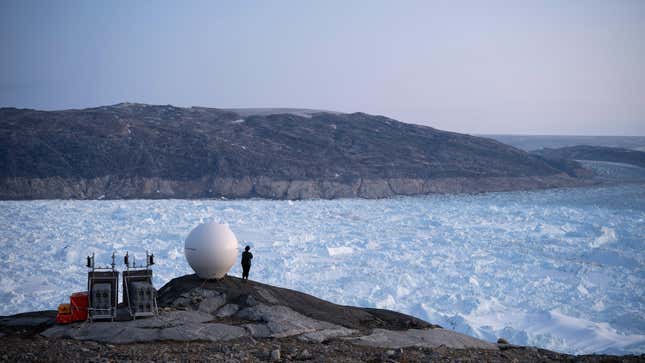
Climate change is rapidly transforming the Arctic into an almost unrecognizable new region, the National Oceanic and Atmospheric Administration’s annual Arctic Report Card has found.
The report, released Tuesday and authored by 147 scientists from 11 countries, is full of cheerful updates on just how quickly climate change is altering one of the world’s most sensitive regions. For instance, the report finds that 2022 had the sixth warmest air temperatures ever recorded in the Arctic; the past seven years have together been the warmest since records began in 1900. To make matters even worse, 2022 marked the 25th consecutive year that the Greenland ice sheet, which “has immediate and global influence on sea level rise,” has ended the year smaller than it began. Fun!
This is the 17th year that NOAA has been compiling this comprehensive, peer-reviewed research on the Arctic, and the length of the report card format really helps to drive home the gravity of some of these yearly metrics that, in isolation, don’t seem as extreme as in other years. In 2022, sea ice cover in the Arctic rebounded after record lows in 2021; 2022 ice levels, however, were still far below the median observed from 1981 to 2010. Similarly, vegetation growth on the tundra—what’s known as greening—was down in parts of the Arctic compared to 2021 and 2020, but this year was still the fourth-biggest for greening since scientists started taking measurements in 2000.
Even when some certain conditions seemed to be trending in a good direction, the large-scale changes going on in the region can quickly counteract that. Snow accumulation across the Arctic was above average during the 2021-2022 winter season, but the onset of spring and warmer temperatures quickly melted all that extra snow, creating a snow-free spring in Eurasia that was 30% to 50% longer than usual. Colder temperatures at the start of the summer, meanwhile, meant that the Greenland ice sheet didn’t melt very much through the season. Come September, however, the ice sheet experienced an “unprecedented” melting event during a severe heatwave that took out more than one-third of the ice sheet’s total surface area.
This report is the first Arctic Report Card to address precipitation, a notoriously difficult set of trends to measure in the region. Climate change is helping increase atmospheric moisture which, generally, has contributed to greater overall precipitation globally, creating heavier rain and snowfall events. In the Arctic, the report finds, the period from September 2021 to October 2022 was the third-wettest year on record since 1950; the only two wetter years were in 2018 and 2020. This shift in precipitation, the report finds, also correlates with regions in the Arctic where sea ice has become scarcer, which lets storms strengthen over warmer and open ocean waters.
“On the fringes of the [Arctic] region…in the next few decades we’re going to see a major transition from snow to rain,” John Walsh, a research professor at the International Arctic Research Center and one of the authors of the report card, said at a press conference at the American Geophysical Union conference in Chicago on Tuesday. “Rain will become the predominant precipitation yearly.”
All this mess in the Arctic is not only changing ecosystems and wildlife but also seriously impacting human life and culture. Indigenous folks living in the region are experiencing massive and wide-scale changes to their way of life, as described in a chapter of the report card that advises policymakers to work more closely with Indigenous knowledge holders on solutions. And many of the world’s major powers are taking advantage of the changes in the north: satellite data shows increasing shipping in areas of the Arctic previously covered by ice, opening up new routes for global trade and exposing ecosystems to new kinds of damage from human activity.
“The wolf is in the house,” NOAA Administrator Rick Spinrad said at the AGU conference, speaking of a recent trip he took to Alaska. “By that I mean that the climate impacts we’re seeing in Alaska—melting permafrost that’s warping roads, melting ice that’s forcing entire Indigenous communities to relocate, warming waters that are forcing fish to migrate and having ripple effects for the entire Alaskan seafood industry, fire seasons that last far longer than they ever have—that’s just a snapshot of what parts of the Lower 48 might expect in the very near future.”